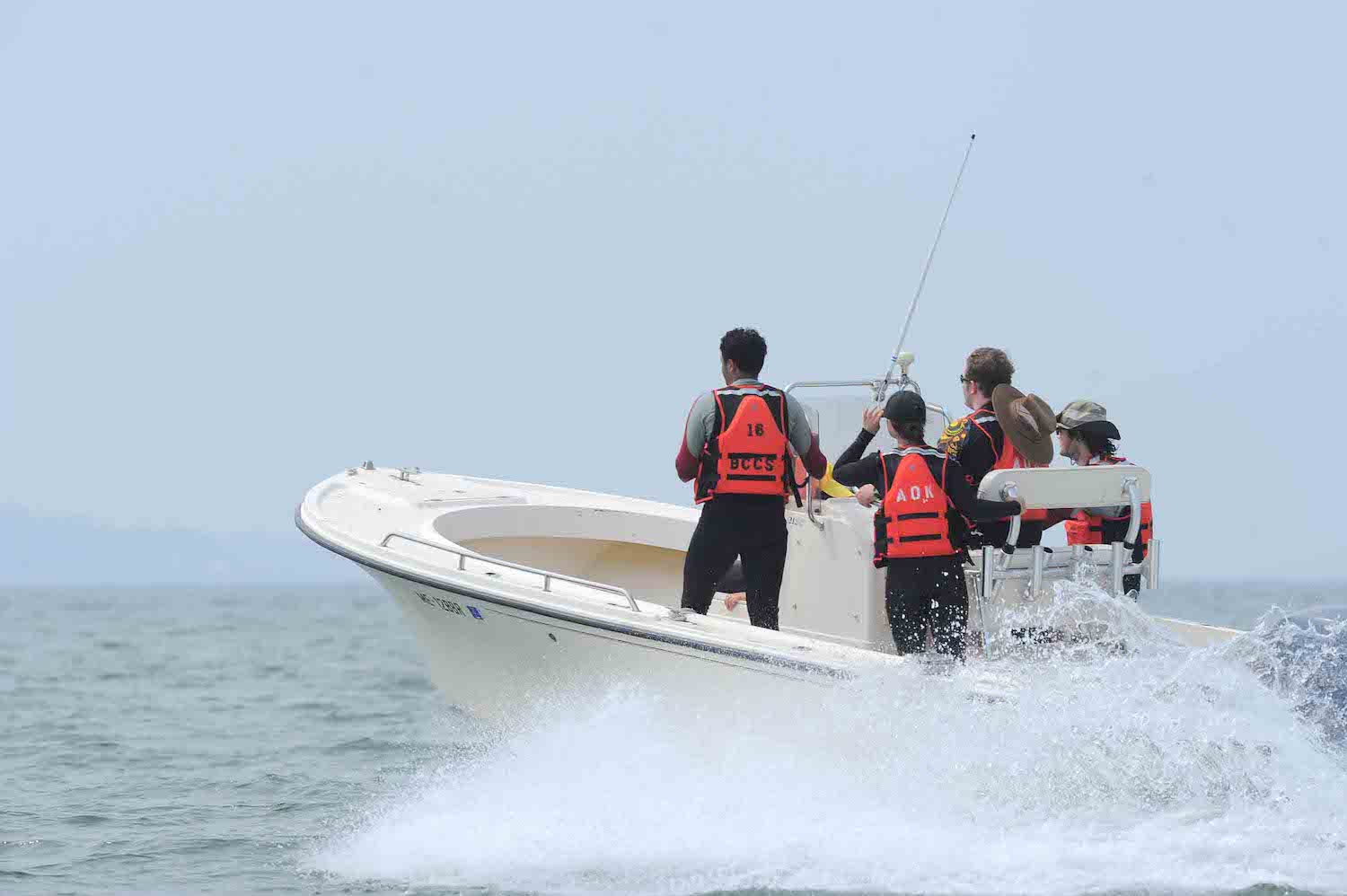Unlikely Friendship? The Story of Eelgrass and Oysters
By Rebecca Goldfine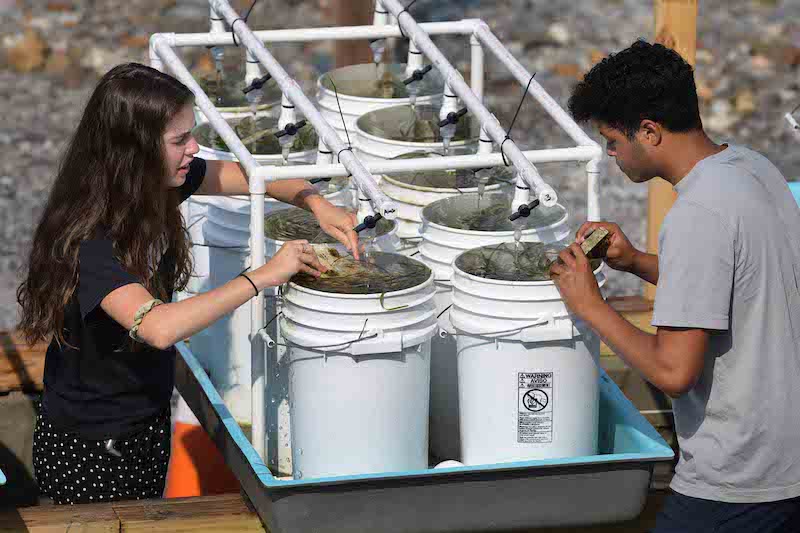
Fiona Ralph and Eban Charles have Henry L. and Grace Doherty fellowships this summer to do coastal research at the Schiller Coastal Studies Center.
The First Chapter
Just outside the Schiller Coastal Studies Center's wet lab, water in overflowing buckets ripples gently as seawater flows in. Each seven-gallon bucket contains either young oysters or eelgrass, or has the two species cohabiting. The water streaming into the buckets comes directly from the ocean near the lab, or has been treated to mimic ocean conditions a century from now—that is, when the water is warmer and/or more acidic.
The two students who set up this intricate system of tanks, piping, valves, and buckets—Eban Charles ’23 and Fiona Ralph ’22—affectionately refer to it as their "seagrass garden." (They also like to call themselves "plumbers," since they labored with power tools to piece together all the PVC piping and fittings earlier in the summer.)
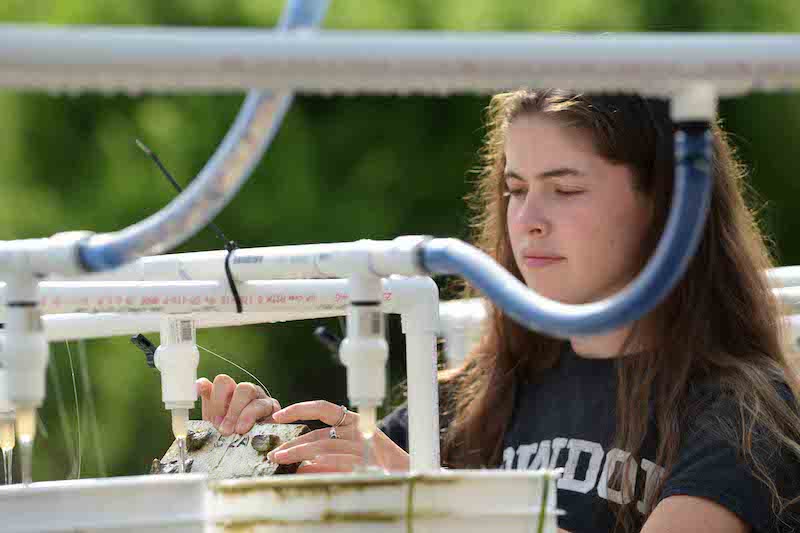
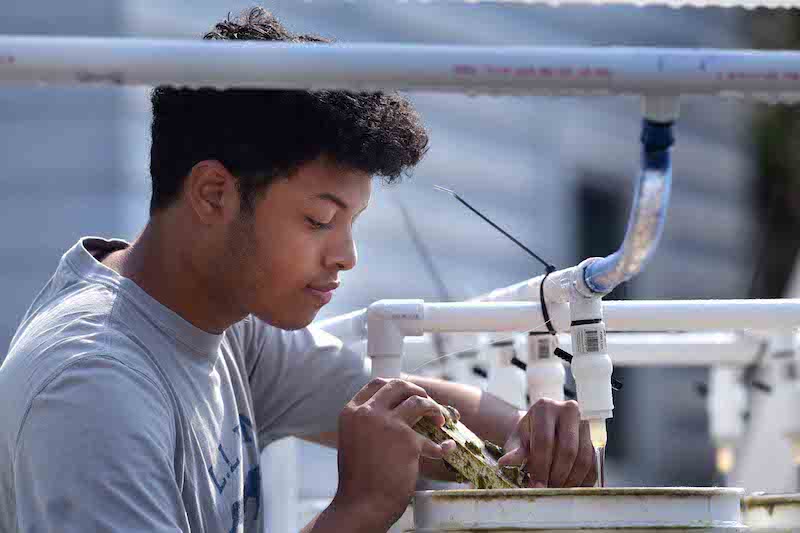
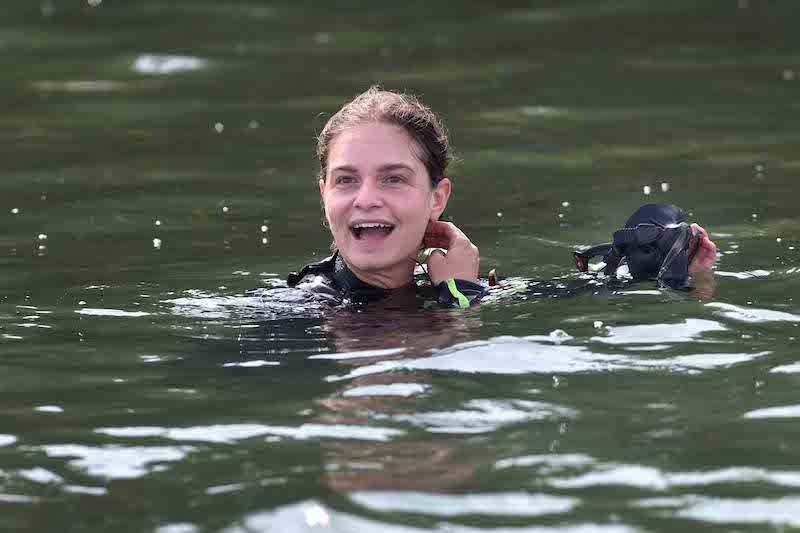
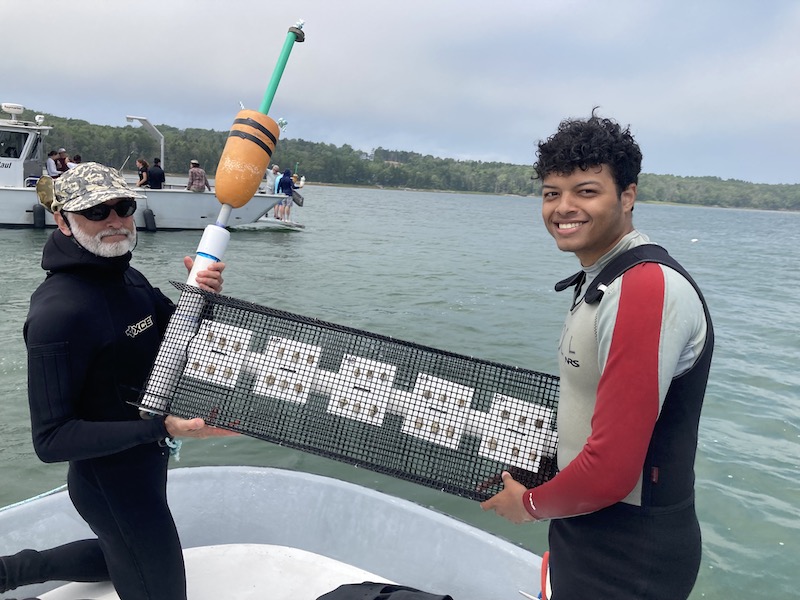
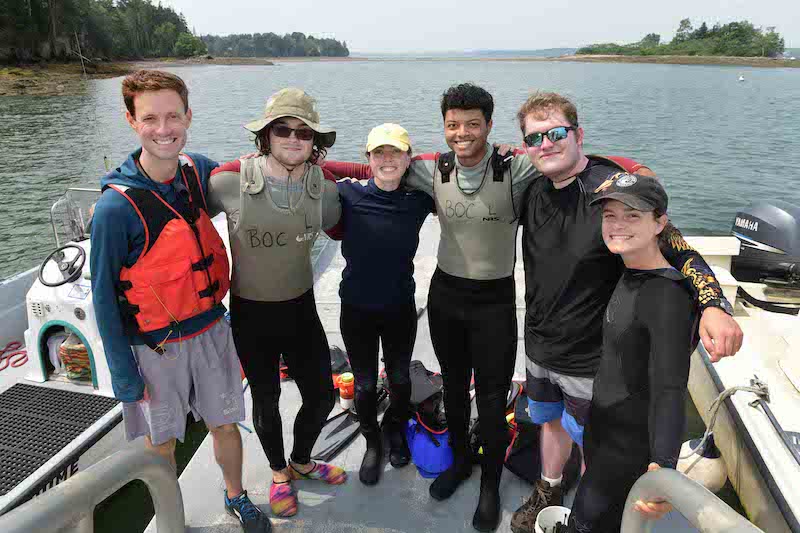
The two biology majors are working with three Bowdoin faculty—Katie DuBois ’11, Bowdoin's current Doherty Marine Biology Postdoctoral Scholar; Dave Carlon, director of the Schiller Coastal Studies Center; and Justin Baumann, visiting professor of biology. DuBois is a seagrass specialist, while Carlon and Bauman are knowledgeable about marine inverterbates, experimental design, and ocean acidification.
The team has also partnered with a neighboring oyster farmer, Pat Scanlan of Snow Island Oysters, who provided support for the research through his nonprofit Quahog Bay Conservancy.
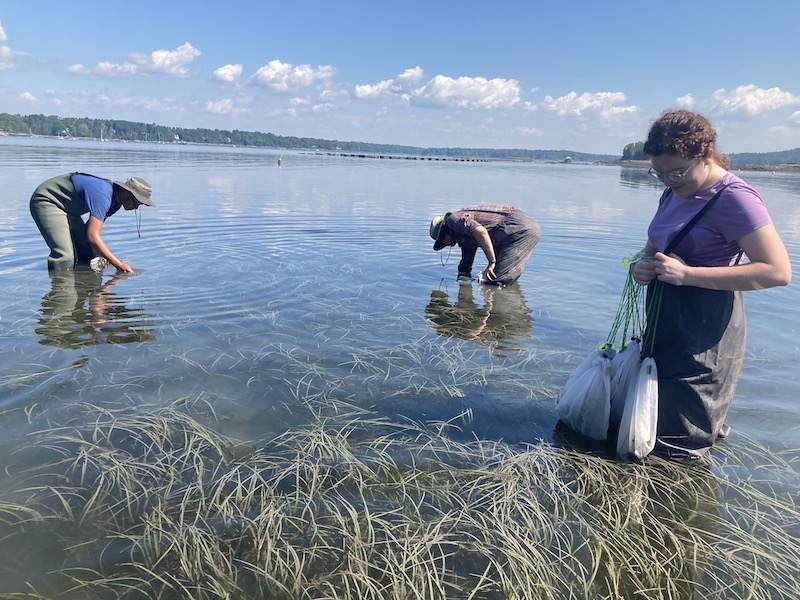
In addition to their controlled experiment in buckets, the team has set up a series of cages filled with baby oysters at Scanlan's nearby aquaculture sites, which are adjacent to eelgrass beds, to watch the interaction of the two species in a more natural setting.
"We're coupling a field experiment at the farms with a mesocosm experiment, which is lab-based experiment on a fairly large scale," Carlon said, referring to the bucket system. "We're testing a similar effect, both in the lab and the field, because we want to know whether eelgrass positively affects oyster growth, and if we see that effect both in the lab and in the field."
The Quahog Bay Conservancy, which is helping to support the oyster-eelgrass research, is a local nonprofit run by Pat Scanlan that is dedicated to increasing the water quality and environment in Quahog Bay and Harpswell Sound.
Among the support Scanlan provided the Bowdoin researchers, he and his staff built twelve oyster cages and allowed them to be placed at two of his aquaculture sites.
Scanlan said he welcomed the opportunity to collaborate with the College. "We're in each other's backyards," he pointed out. One of his sea farms is visible from the Coastal Studies Center dock. "This is a great start to a more permanent partnership," he added.
Carlon said Scanlan's participation made the research project possible, and that his support has been "huge." Depending on what the researchers discover, their findings could impact Scanlan's oyster business, whose proceeds support his nonprofit.
"We're interested in the relationship between seagrass and oysters and in an environment that is right next to his floats, so if there is an impact of seagrass on oyster growth, we can extrapolate that to his business, his farm," Carlon said.
In mid-August, after approximately four weeks, Charles and Ralph will assess the growth of each oyster—all 480 of them in the buckets—as well as the ones at the aquaculture sites. They'll measure shell length and weight, as well as tissue mass. They'll also measure the growth of the 600 strands of eelgrass in the buckets. Throughout the experiment, they have been collecting data on the buckets' water chemistry.
While their final results won't be ready until the fall, when the scientists plan to submit a paper to a peer-reviewed journal, their research has the potential to impact Maine's oyster farmers. "I think it is so important to tie economic interests and small businesses to restoration and ecology whenever you can," DuBois said.
Though many commercial fisheries are declining in Maine, others, like oyster aquaculture, are on the rise. As more sea farms pop up along the coast, some coastal stakeholders worry they could harm eelgrass meadows by competing for space and blocking sunlight. Consequently, the state carefully issues site permits for new oyster farms to avoid eelgrass beds.
The concern about protecting eelgrass is understandable, for the hardy, tall grasses play a critical role in the marine ecosystem. Plus, for many years eelgrass beds appeared to be in decline (that trend may be reversing—a phenomenon DuBois is investigating).
"Eelgrass is important because it forms these large marine meadows—picture this lush prairie underwater," described DuBois. "In Maine, the grasses can be three to four feet tall, so they make this incredible three-dimensional habitat that fish and lobsters love. Baby mussels use it as habitat. Crabs love it, too. Any important coastal fishery likes to live in eelgrass in their juvenile stage of life, and that improves survival and abundance for all these different species."
Just as importantly, eelgrass is a "blue carbon" ecosystem, helping to buffer the worst effects of climate change. "Seagrass is one of the great carbon sequesters," DuBois said. "One of the greatest of any natural habitat."
As humans keep pumping carbon into the atmosphere, the sea continues to absorb much of this excess. Under the sea, carbon-loving seagrass sucks up a lot of the greenhouse gas, storing it safely away for many years. "Seagrass acts like a fairly large carbon sink," Carlon said. "It stays in the benthic system and doesn't reenter the atmosphere for hundreds or even thousands of years."
Why might oysters and eelgrass make such a good pair?
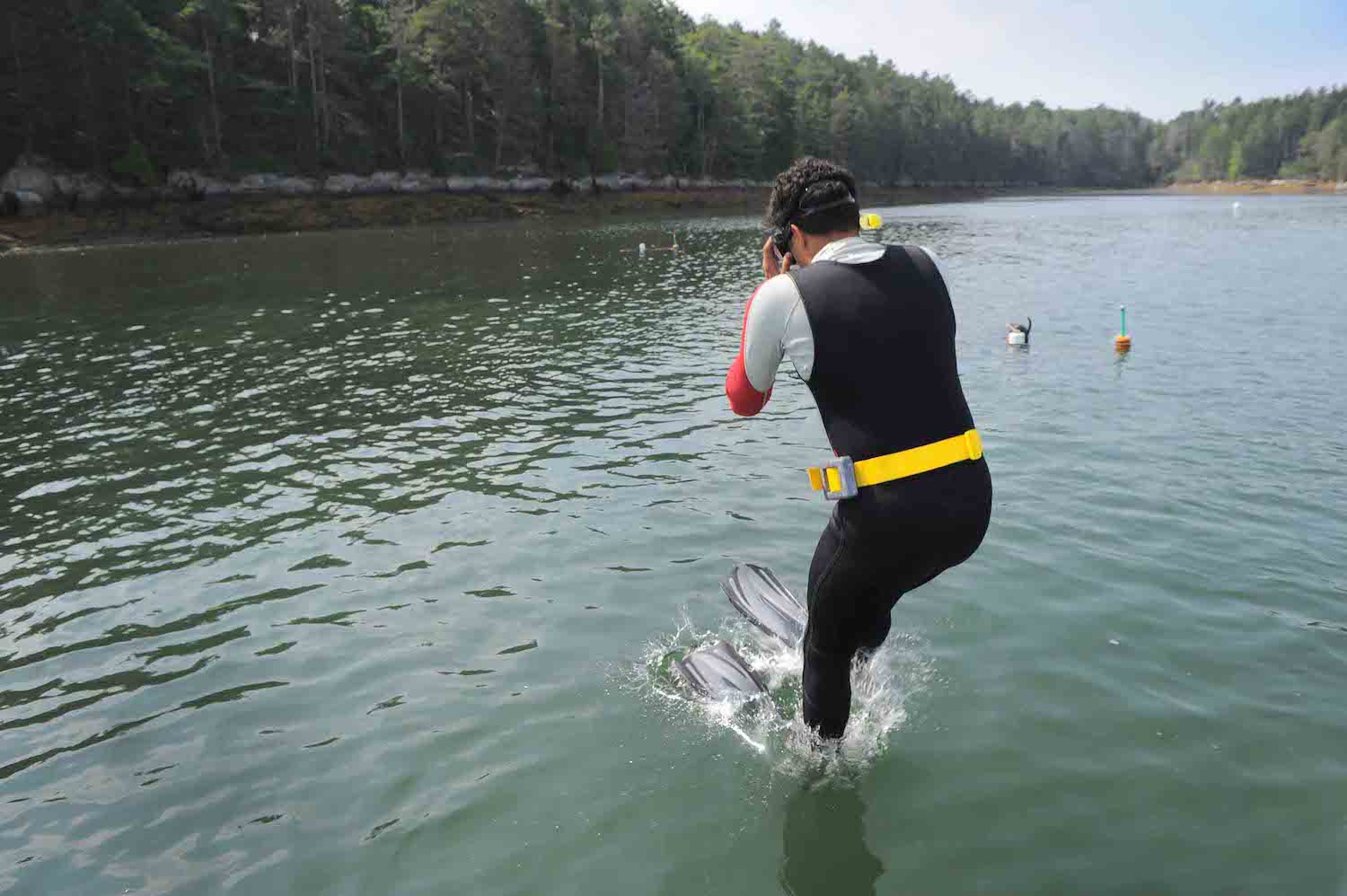
Eelgrass is a temperate species of seagrass that's common in the northern hemisphere, from Maine to Japan. Most eelgrass in Maine is found in fairly shallow coastal waters, in bays and estuaries.
As eelgrass conducts photosynthesis during the day, it pulls in carbon dioxide from the seawater. In this way, it can help ameliorate ocean acidification caused by rising CO2 levels. Oysters calcify or grow their shells faster in less acidic water, "so there is this water chemistry aspect where eelgrass can help oyster growth," DuBois said. "We're not sure we'll see that, but we're hoping to see that."
Oysters, meanwhile, filter seawater through their gills to feast on phytoplankton and small bits of algae. They act like the ocean's filters, drawing in nutrients and pathogens dangerous to the grasses, cleaning and purifying the water column. Cleaner and clearer water is better for seagrass, in part because it allows more light to penetrate the murky depths and sustain the underwater plants.
To study the interaction between eelgrass and oysters—now and in the future—the Bowdoin researchers have set up different sea conditions in each of their forty-five buckets. A third of the buckets contain just oysters, fifteen have only eelgrass, and fifteen have a combination of grass strands and juvenile oysters.
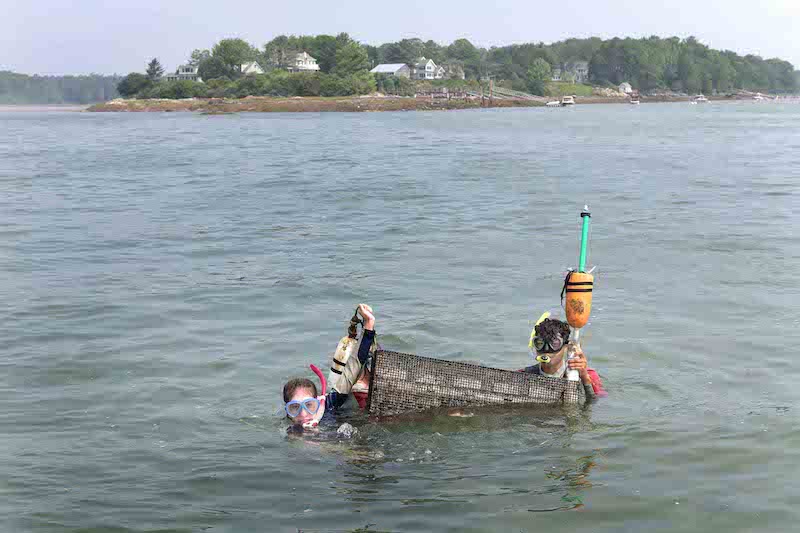
Of those three sets of fifteen buckets, five are treated with seawater piped in from the bay. Five are filled with seawater that has been warmed 1.5 degrees Celsius. Five are treated with seawater that is not only warmer but has more carbon dioxide, making it more acidic.
"We're doing that to mimic the Gulf of Maine environment in, say, 2100," Carlon said. "And the idea is that if there are these specific interactions at current-day temperatures and ocean acidity, does that interaction change at all with climate change? Maybe it's a stronger effect."
Meanwhile, at the two aquaculture sites, the researchers have set up some oyster cages directly over robust eelgrass beds, some cages over patchier beds, and some over mudflats.
"The goal is to compare the growth rates of oysters between locations," Charles said. "So overall, we're hoping to see that the oysters in seagrass grow faster than the oysters in mudflats."
While their hypothesis is that the two species do positively influence each other's productivity, Carlon said at this point, "the experiment could go either way. We we are measuring the impacts, so we can see whether it is positive or negative for both species."
Yet, if they do find a positive impact, that could mean good news for oyster farmers, who might have to worry less about damaging eelgrass beds and even welcome the encroachment of those beds growing near their farms.
In the future, Carlon anticipates his team will test the effect of shading on eelgrass beds, to see how farmers' oyster floats affect eelgrass and to possibly recommend their placement to encourage the healthiest interaction.
For Charles and Ralph, the summer has been like a concentrated Bowdoin Marine Science Semester, which Charles will be attending in the fall. "Working with this group is such a privilege," he said. "They're so knowledgeable and can contribute to your growth as a student and researcher."
Ralph agreed, noting, too, that collaborating with oysters farmers provides an extra dimension to the project. "This is not only like a traditional summer research experience," she said, "it is more than that because of the leadership we have and the scale of the project. It's been cool to network with oyster farmers and to see the commercial side of this. The project could have actual ramifications in the real world that the farmers can see and use for their benefit."
